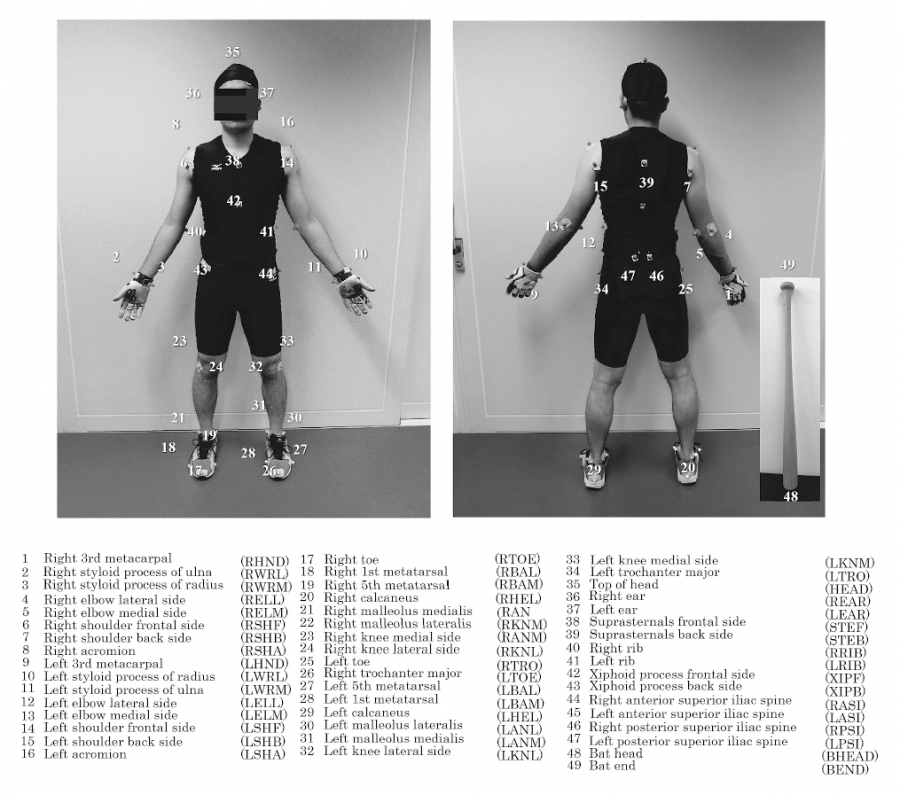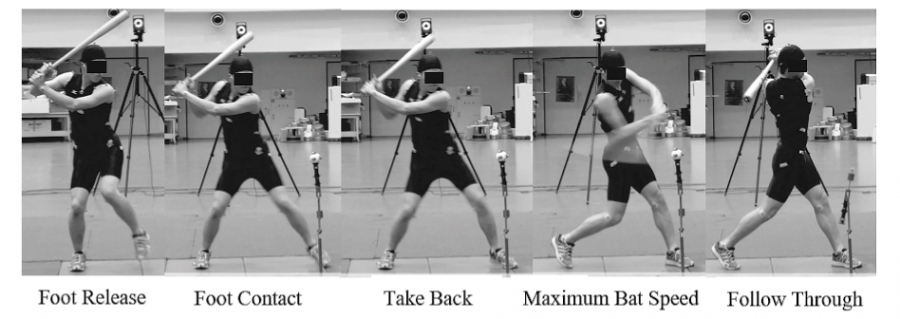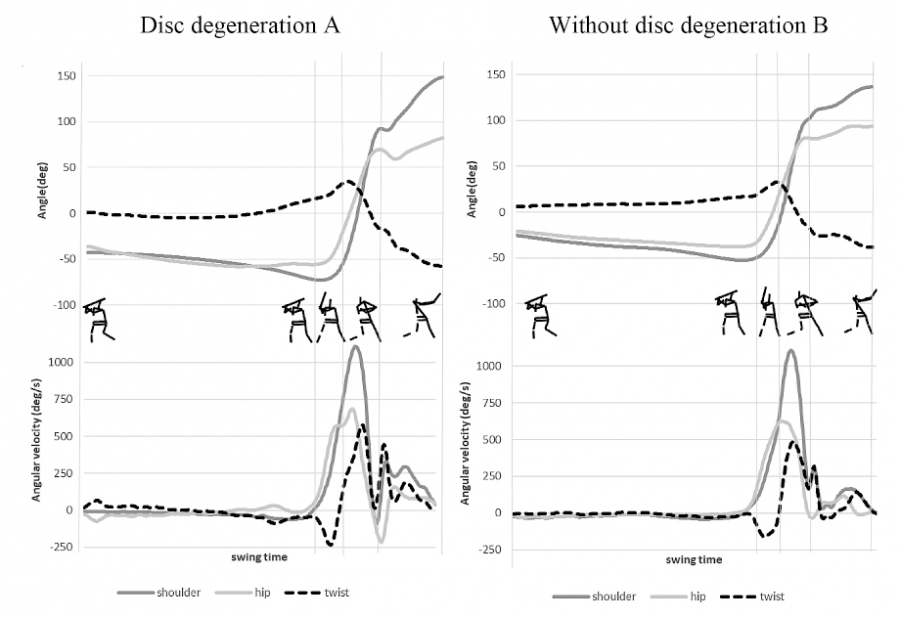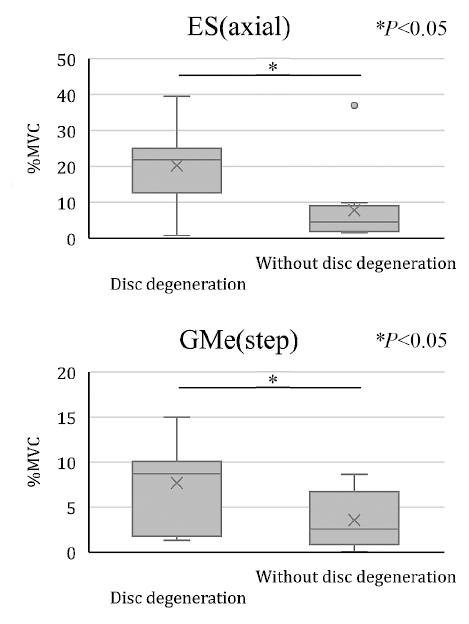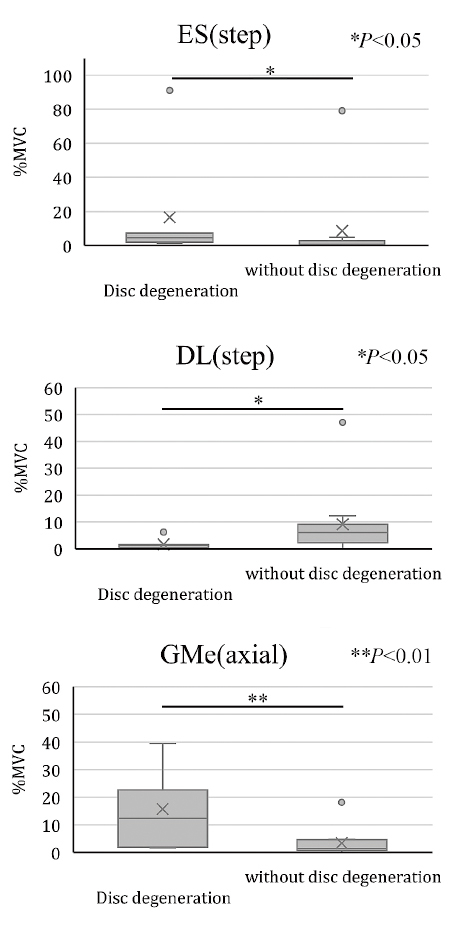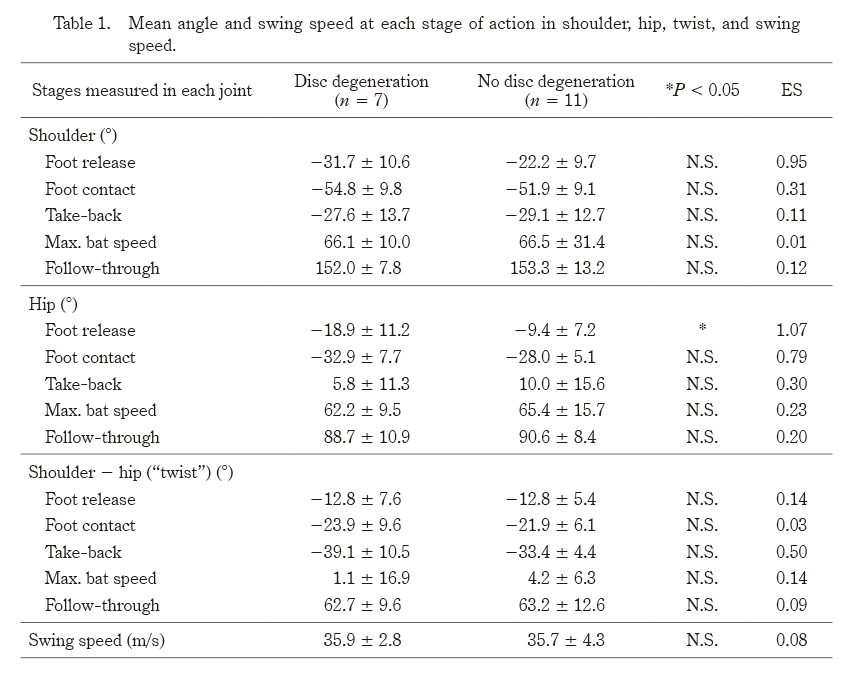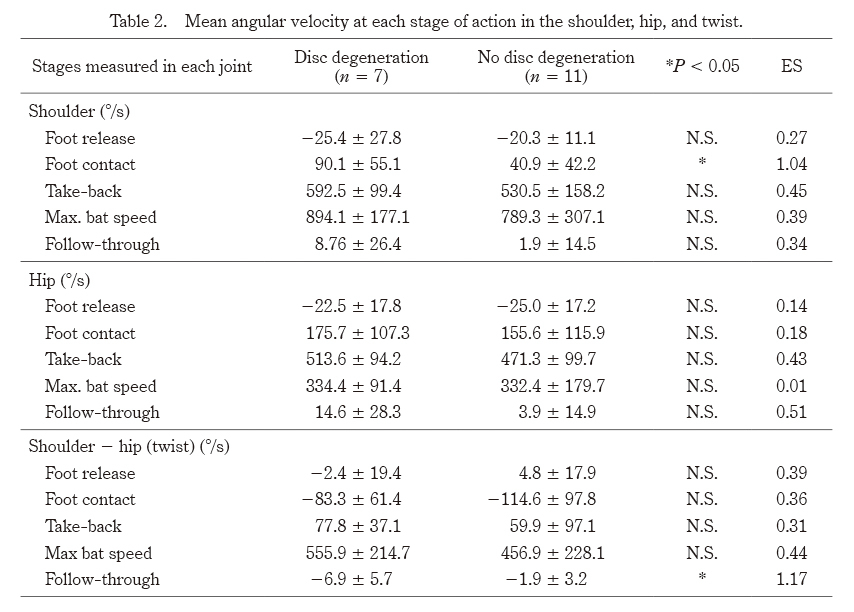Lower back pain (LBP) is common among baseball players, and the occurrence of lumbar intervertebral disc degeneration is high. The dynamic load on the lumbar spine due to the postures and movements characteristic of baseball is suspected of aggravating LBP caused by degeneration, but the difference in batting action between players with and without degeneration is not known. The purpose of this study was to investigate the difference in batting motion in the presence and absence of lumbar disc degeneration (LDD). The subjects were 18 male baseball players belonging to the University League Division I: seven with disc degeneration and 11 without. The motion task analyzed tee batting. The items examined were the angles of rotation of shoulder, pelvis, hip, and twisting motion; rotation angular velocity; time to maximum angular velocity; and muscle activity potentials of the bilateral latissimus dorsi, erector spinae, multifidus, external oblique, internal oblique, rectus abdominis, and gluteus medius muscles; at each stage of batting action. There were significant differences between the shoulder and pelvis in rotation angle, time to maximum angular velocity, and muscle activity in the presence and absence of LDD, and in the time to maximum angular velocity between the shoulder and pelvis. We infer that these differences are characteristic of batting motion due to LDD.
Abstract/References
Analysis of trunk rotation during baseball batting with lumbar disc degeneration
Naoki Taguchi, Shigeki Izumi, Shumpei Miyakawa
-
Naoki Taguchi
Faculty of Sports Science, Sendai University
-
Shigeki Izumi
Faculty of Sports and Health Studies, Hosei University
-
Shumpei Miyakawa
Faculty of Medicine, University of Tsukuba
Abstract
References
1. Dick R, Sauers EL, Agel J, Keuter G, Marshall SW, McCarty K, McFarland E. Descriptive epidemiology of collegiate men’s baseball injuries:National Collegiate Athletic Association Injury Surveillance System, 1988-1989 through 2003-2004. J Athl Train, 42(2):183-193, 2007.
2. McFarland EG, Wasik M. Epidemiology of collegiate baseball injuries. Clin J Sport Med, 8(1):10-13, 1998.
3. Posner M, Cameron KL, Wolf JM, Belmont Jr PJ, Owens BD. Epidemiology of major league baseball injuries. Am J Sports Med, 39(8):1676-1680, 2011.
4. Wasserman EB, Sauers EL, Register-Mihalik JK, et al. The First Decade of Web-Based Sports Injury Surveillance:Descriptive Epidemiology of Injuries in US High School Boys’ Baseball (2005-2006 Through 2013-2014) and National Collegiate Athletic Association Men’s Baseball (2004-2005 Through 2013-2014). J Athl Train, 54(2):198-211, 2019.
5. Hangai M, Kaneoka K, Okubo Y, et al. Relationship between low back pain and competitive sports activities during youth. Am J Sports Med, 38(4):791-796, 2010.
6. Hangai M, Kaneoka K, Okubo Y, et al. Lumbar Intervertebral Disk Degeneration in Athletes. Am J Sports Med, 37(1):149-155, 2009.
7. Taguchi N, Miyakawa S, Izumi S. Physical Characteristics of Male Collegiate Baseball Players with Lumbar Intervertebral Disc Degeneration. (in Japanese) The journal of Japanese Society of Clinical Sports Med, 27(3):481-488, 2019.
8. Oshikawa T, Morimoto Y, Kaneoka K. Unilateral rotation in baseball fielder causes low back pain contralateral to the batting side. J Med Invest, 65(1.2):56-59, 2018.
9. Escamilla RF, Fleisig GS, DeRenne C, Taylor MK, Moorman CT, and Andrews JR. A comparison of age level on baseball batting kinematics. J Appl Biomech, 25(3):210-218, 2009.
10. Shaffer B, Jobe FW, Pink M, and Perry J. Baseball Batting:An electromyographic study. Clin Orthop Relat Res, 292:285-293, 1993.
11. Fleisig GS, Hsu WK, Fortenbaugh D, Cordover A, Press JM. Trunk axial rotation in baseball pitching and batting. Sports Biomech, 12(4):324-333, 2013.
12. Sairyo K, Katoh S, Komatsubara S, et al. Spondylolysis fracture angle children and adolescents on CT indicates the fracture producing force vector - A biomechanical rationale. Internet J Spine Surg, 1(2):2, 2005.
13. Selhorst, M, Fischer, A, MacDonald, J. Prevalence of spondylolysis in symptomatic adolescent athletes:an assessment of sport risk in nonelite athletes. Clin J Sport Med, 29(5):421-425, 2019.
14. Oshikawa T, Koji Kaneoka K, Morimoto, Akuzawa H. Comparison of Lumbar Kinematics with a History of Low Back Pain During Baseball Batting. Int J Sports Med, 41(2):119-127, 2020.
15. Oyama S, Yu B, Blackburn JT, Padua DA, Li L, Myers JB. Improper trunk rotation sequence is associated with increased maximal shoulder external rotation angle and shoulder joint force in high school baseball pitchers. Am J Sports Med, 42(9):2089-2094, 2014.
16. Pfirrmann CW, Metzdorf A, Zanetti M, Hodler J, Boos N. Magnetic resonance classification of lumbar intervertebral disc degeneration. Spine, 26(17):1873-1878, 2001.
17. Kaneoka K, Shimizu K, Hangai M, et al. Lumbar intervertebral disk degeneration in elite competitive swimmers:a case control study. Am J Sports Med, 35(8):1341-1345, 2007.
18. Wells RP, Winter DA. Assesment of signal and noise in the kinematics of normal, pathological and sporting gaits. In Human Locomotion, 1:92-93, 1980.
19. Hermens HJ, Freriks B, Merletti R, et al. Stegeman D, Block J, Rau G, et al. SENIAM European Recomendation for Surface Electromyography. 8th Edn Enschede:Roessingh Research and Development b.v, 1999.
20. Avers D, Brown M. Daniels and Worthingham’s Muscle Testing:Techniques of Manual Examination and Performance Testing (10thed). Saunders, 2018.
21. Cohen J. Statistical Power Analysis for the Behavioral Sciences. 2nd ed. Hillsdale, NJ: Lawrence Erlbaum Associates, 1988.
22. Chu SK, Jayabalan P, Kibler WB, Press J. The Kinetic Chain Revisited:New Concepts on Throwing Mechanics and Injury. PM & R, 8(3 Suppl):S69-77, 2016.
23. Kibler WB, Kuhn JE, Wilk K, et al. Sciascia A, Moore S, Laudner K, Ellenbecker T, Thigpen C, Uhl T. The disabled throwing shoulder: spectrum of pathology-10-year update. Arthroscopy, 29(1):141-161.e26, 2013.
24. Sciascia A, Thigpen C, Namdari S, Baldwin K. Kinetic chain abnormalities in the athletic shoulder. Sports Med Arthrosc Rev, 20(1):16-21, 2012.
25. Wight J, Richards J, Hall S. Influence of pelvis rotation styles on baseball pitching mechanics. Sports Biomech, 3(1):67-83, 2004.
26. Urbin MA, Fleisig GS, Abebe A, Andrews JR. Associations between timing in the baseball pitch and shoulder kinetics, elbow kinetics, and ball speed. Am J Sports Med, 41(2):336-342, 2012.
27. Welch CM, Banks SA, Cook FF, et al. Hitting a baseball:A biomechanical description. J Orthop Sports Phys Ther, 22(5):193-201, 1995.
28. Kumar S, Narayan Y, Garand D. An electromyographic study of isokinetic axial rotation in young adults. Spine J, 3(1):46-54, 2003.
29. Kumar S, Narayan Y, Garand D. Isometric axial rotation of the human trunk from pre-rotated postures. Eur J Appl Physiol, 87(1):7-16, 2002.
30. Panjabi MM. The stabilizing system of the spine. Part I. Function, dysfunction, adaptation, and enhancement. J Spinal Disord, 5(4): 383-389;discussion 397, 1992.
31. Ng JK, Richardson CA, Parnianpour M, and Kippers V. EMG activity of trunk muscles and torque output during isometric axial rotation exertion:a comparison between back pain patients and matched controls. J Orthop Res, 20(1):112-121, 2002.
32. Michael Boyle. Functional Training for Sports. Human Kinetics, 2004.
33. Hodges, PW, Richardson, CA. Inefficient muscular stabilization of the lumbar spine associated with low back pain. A motor control evaluation of transversus abdominis. Spine, 15:2640-2650, 1996.
34. van Dieën JH, Cholewicki J, Radebold A. Trunk muscle recruitment patterns in patients with low back pain enhance the stability of the lumbar spine. Spine, 28(8):834-841, 2003.
35. Panjabi MM. The stabilizing system of the spine. Part II. Neutral zone and instability hypothesis. J Spinal Disord, 5(4):390-396;discussion 397, 1992.
36. Okubo Y, Kaneoka K, Imai A, et al. Electromyographic analysis of transversus abdominis and lumbar multifidus using wire electrodes during lumbar stabilization exercises. J Orthop Sports Phys Ther, 40(11):743-750, 2010.
Figures

